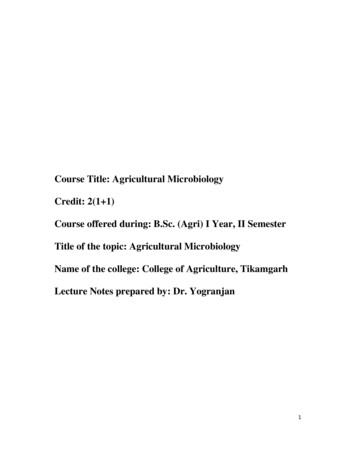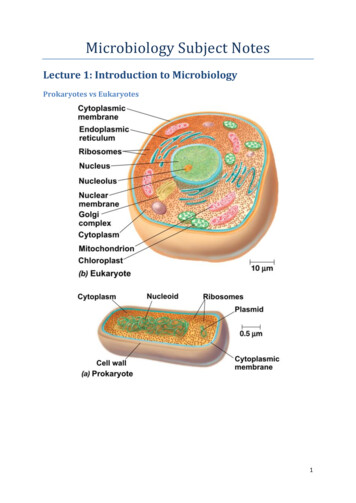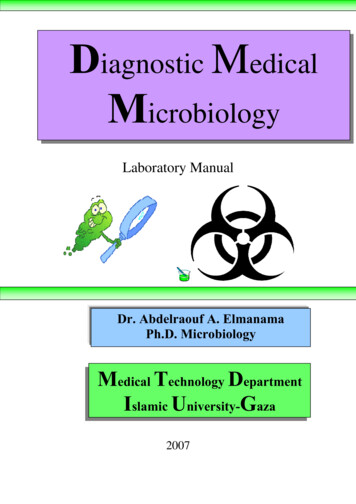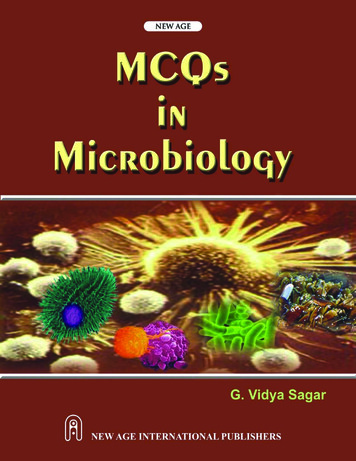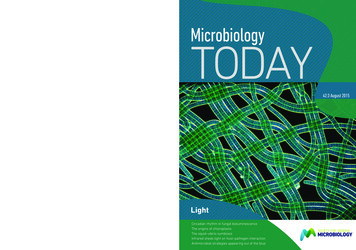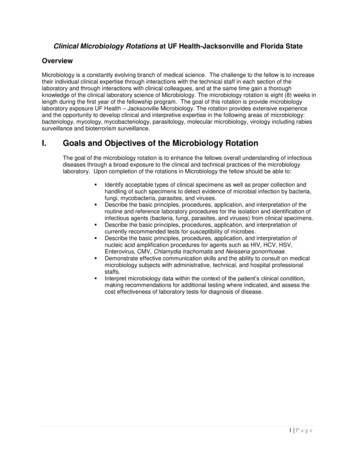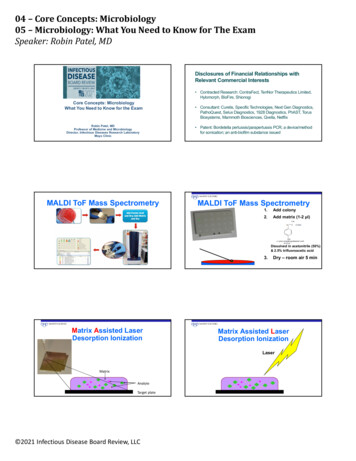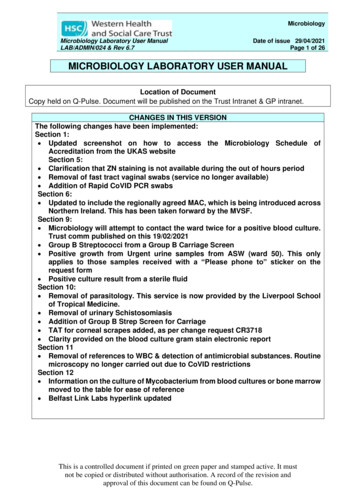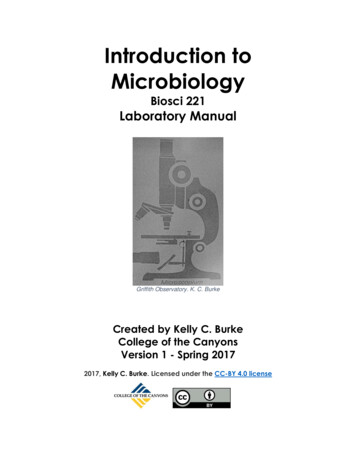
Transcription
Introduction toMicrobiologyBiosci 221Laboratory ManualGriffith Observatory. K. C. BurkeCreated by Kelly C. BurkeCollege of the CanyonsVersion 1 - Spring 20172017, Kelly C. Burke. Licensed under the CC-BY 4.0 license
College of the Canyons – BIOSCI 221 Kelly C. BurkeAttributions:Created By:Kelly C. BurkeImportant Information about This BookEdits Made By:Natalie Miller &Frederick BobolaThis book was made possible by fundingthrough College of the Canyons andthe support ofChancellor Dianne G. Van HookSpecial thanks to:The Distance Learning TeamUnless otherwise stated, all unlabeled images in thisbook are under Kelly C. Burke CC BY-NC SA 4.02 Introduction
College of the Canyons – BIOSCI 221 Kelly C. BurkeTable of ContentsSafety . 4The Metric System, Measurement, and Lab Equipment Review . 13Microscopy . 25Environmental Sampling . 38Survey of Eukaryotic Microorganisms: The Protists Algae. 45Parasitic Helminths . 52Fungi . 59Pure Cultures: Aseptic Transfer Techniques and Streak Plates for Isolation . 69Bacterial Growth Patterns: Building your Stock Cultures and Observing CultureCharacteristics . 76Bacterial Growth Patterns: Direct Count, The Standard Plate Count, and IndirectTurbidimetric Methods . 82Environmental Effects on Growth: Tempature . 93Environmental Effects on Growth: pH . 99Environmental Effects on Growth: Osmotic Pressure. 103Oxygen Requirements: FTM and the Anaerobe Jar. 106Environmental Effects on Growth: Antimicrobial Sensitivity Testing . 110Transformation 1. 114Smear Prep and Simple Stains . 122Negative Stain . 133Gram Stain . 139Endospore Stain . 148Acid-Fast Stain: Kinyoun Method . 154Physiological Tests for Characterization and Identification of Bacteria . 160Unknown #1 . 182Unknown #2: Mixed Culture . 186Bacterial Examination of Food: Standard Plate Counts . 188Bacterial Examination of Water: Multiple Tube Test, Standard Plate Count, andMembrane Filter Technique. 192Immunology: ELISA-Simulation, StaphTEX-Agglutination Reaction . 198Microbescopes and Observation of Natural Samples . 2023 Introduction
College of the Canyons – BIOSCI 221 Kelly C. BurkeSafetyAt College of the Canyons we are very concerned about safety in our Intro to Microbiology labs. Safety ismore important than anything else and many of our rules, techniques, and behaviors we teach are toensure the safety of our students, staff, instructors, etc. In 2013 the American Society for Microbiology(ASM) established guidelines for teaching labs. Most of the organisms we use in our labs are BSL-1;however, we follow the BSL-2 guidelines because we feel that they instruct students on preferred safetyprocedures and we occasionally use Staphylococcus aureus, a BSL-2 bacterium. ASM worked onguidelines due to infections acquired from clinical and teaching labs, noted below. The organism inquestion is a BSL 2 bacterium and is NOT used in our laboratories.“The low reported incidence of infections associated with microbiology teaching laboratoriessuggests that these laboratories are relatively safe (3). However, the importance of biosafety inthe laboratory is highlighted by recent multi-state infections by Salmonella Typhimuriumassociated with clinical and teaching laboratories. Between August 2010 and June 2011 theCenters for Disease Control and Prevention (CDC) linked Salmonella Typhimurium infections in109 individuals ranging in age from one to 91 years old to a strain used in clinical and teachinglaboratories. The infections included twelve hospitalizations and one death (1).” 1Learning Objectives:After this lab you should be able to:1. List important safety rules.2. Identify infractions in safety.3. Comply with and perform the correct safety procedures during lab.4. Define Biosafety Levels (BSL-1-4).5. Compare and contrast BSL-1 and BLS-2 organisms and their lab safety requirements.Introduction:You will receive instruction on many safety concerns. Keep the handouts to learn from and refer to.Some safety protocols will be introduced later but are referenced here and on the included handouts.The most important things are:1. Be prepared—read ahead and know what you will be doing in lab on any given day.2. Follow ALL safety instructions.3. ASK if you don’t know what to do.4 Introduction
College of the Canyons – BIOSCI 221 Kelly C. BurkeMaterials:Included in this lab manual Autoclave Instructions (Separate)Biosafety Level (BSL) ChartDisposal of Biohazardous MaterialsSafety Rules-General and Microbiology specificStudent Agreement (separate)Procedures:Review the following and the handouts. Sign the acknowledgement form.College of the CanyonsBiological Science DepartmentLaboratory Safety GuidelinesEach laboratory is a restricted area. Enrolled students may work in a lab only when there are authorizedpersonnel present. Friends of students in lab classes will not be allowed to “visit” inside the laboratory.Students are not permitted into the storage rooms or prep areas unless given specific permission by theirinstructor or lab personnel.Ensuring safety in the laboratory is the responsibility of everyone working in the lab. Please follow theseguidelines carefully.GENERAL GUIDELINES:USE COMMON SENSE WHEN WORKING IN THE LAB.Be prepared for your work in the lab. Read all procedures thoroughly before entering the lab. Follow allwritten and verbal instructions carefully. If you do not understand a direction or part of a procedure, askthe instructor before proceeding.Do not eat, drink or smoke in the lab. Do not use laboratory glassware as containers for food orbeverages.Always wear close-toed shoes in the lab.Wear safety goggles whenever working with chemicals or when there is an impact risk.Long hair should be tied back when working with flames, chemicals or dissections.Observe good housekeeping practices. Work areas should be kept clean and tidy at all times. Keep aislesclear. Push your chair under the desk when not in use.No open flames are permitted in the laboratory unless specifically indicated by the instructor. Whenburners or hot plates are being used, caution should be exercised to avoid thermal burns. If you sustain athermal burn immediately flush the area with cold water and notify the instructor.If there is a blood spill, immediately notify the instructor.ANY ACCIDENTS OR INJURIES THAT OCCUR IN THE LAB MUST BE REPORTED TO THEINSTRUCTOR AT ONCE.Familiarize yourself with the location of the Fire Extinguisher. There is a telephone in each lab room forEMERGENCY use only. In case of emergency dial 7 to reach the school operator who will contact anddirect the emergency personnel.Broken glass is to be disposed of in the broken glass container and reported to the instructor.Keep hands away from face, eyes, mouth and body while using chemicals or preserved specimens.Wash your hands with soap and water after performing all experiments. Clean, rinse and wipe dry all work5 Safety
College of the Canyons – BIOSCI 221 Kelly C. Burkesurfaces and apparatus at the end of the experiment. Return all equipment cleaned and to the properarea.Handle all living organisms used in a lab activity in a humane manner.Never use mouth suction to fill a pipet. Use a rubber bulb or pipet pump.When removing an electrical plug from its socket, grasp the plug, not the electrical cord. Hands must becompletely dry before touching an electrical switch, plug or outlet.HANDLING CHEMICALSWear safety goggles whenever working with chemicals.Chemicals and biological stains should be used with caution. Follow specific directions regarding allchemicals used during lab. Check the label on chemical bottles twice before removing any of thecontents. Take only as much chemical as you need.If any chemical comes into contact with your skin, immediately flush the area with water for severalminutes and notify the instructor. A strong base feels soapy on your skin but will still cause a severe burn.Familiarize yourself with the location of the chemical eyewash. If any chemical is splashed into your eyes,hold eyelids open and flush with water for 15 minutes. Notify the instructor.Dispose of all chemical waste properly. Do not pour chemicals down the sink unless told to do so by yourinstructor. Check the label of all waste containers twice before adding your chemical waste to thecontainer.DISSECTIONS—Special PrecautionsStudents should consult with the instructor regarding the pros and cons of wearing contact lenses duringdissections.Safety glasses or other protective eyewear is recommended for all students performing dissections.Protective gloves should be worn during dissections. If your skin comes in contact with a chemicalpreservative, immediately run water over the area and notify the instructor.Do not remove preserved specimens from the laboratory.Preserved biological materials are to be treated with respect.When using scalpels and other sharp instruments, always carry with tips and points pointing down andaway. Notify instructor of any cuts or other injuries.MICROORGANISMS—Special PrecautionsWhen working with microorganisms, lab coats must be worn at all times.The laboratory benches must be cleaned with Sanisol (a disinfectant) before and after all lab work.If cultures are spilled in the lab, they must be disinfected. Pour Sanisol over the spill, let stand for 5minutes, then wipe up and dispose of towels in a biohazard receptacle.Never remove cultures from the laboratory.When finished working with a specific culture place it in the biohazard receptacle provided.Agreement: (You will be given a separate sheet to sign and turn in, do not turn this in)I have read and agree to follow the above safety rules for the Biological Science Laboratories.I realize that I must obey these rules to ensure my own safety and that of my fellow students andinstructors.Student SignatureDate6 SafetyStudent Name (print)
College of the Canyons – BIOSCI 221 Kelly C. BurkeMicrobiology Specific Guidelines:These procedures are specific to Microbiology (based on the 2012 ASM Guidelines for BSL 2 teachinglabs) and are in addition to the General Safety Guidelines.1. Safety goggles or safety glasses with side shields are required for laboratory procedures involvingbacterial cultures.2. Wear closed-toe shoes that cover the top of the foot, and heel. You will not be allowed to participate ifyou don’t have on the proper shoes.3. Wear gloves when handling BSL 2 microorganisms or hazardous chemicals, including stains.* 4. Wearlaboratory coats. Coats should cover to the knees. Long pants are recommended. You will not beallowed to participate if you don’t have on the proper attire.5. Wash hands after entering and before exiting the laboratory.6. Tie back long hair.7. Do not wear dangling jewelry, scarfs, etc.8. No food, gum, or water in the lab.9. Do not touch face, including eyes, or use cosmetics in lab.10. Keep hands, pens, pencils, etc., away from mouth (no nail biting!).11. Do not use personal pens, pencils, calculators, etc. in lab. These will be provided for you.12. Cell phones, laptops, etc. are not allowed in lab. If they become contaminated there is no way todisinfect them, and they are a distraction. No exceptions whatsoever. Computers are available in labwhen needed.13. Sanitize lab bench before and after lab activities.14. Use test tube racks when moving cultures and store plates and test tubes as instructed.15. Note the location of biohazardous waste and sharps receptacles. Review the section onbiohazardous waste disposal.16. Notify instructor of all spills or injuries. Clean up spills as instructed.17. If you are pregnant, immune-compromised, or live or work with someone who is, inform yourphysician that you are taking this class.*Special instructions for wearing gloves:Wearing gloves often makes the wearer feel safe, and this is one reason for wearing them.However, one must also be aware that contamination that gets on gloves can then be transferredto other surfaces, people, pens, pencils, microscopes, etc. So it is very important to follow properglove protocols.1. Wear gloves when working with BSL 2 organisms and when staining. Your instructor will letyou know when this is necessary.2. Nitrile gloves are recommended as some people have latex sensitivity. Gloves should fitsnuggly. Loose gloves are hazardous in themselves.3. Gloves are flammable/melt. Use caution when using near a heat source like the Bactincinerators and hot plates.4. If gloves become contaminated with a bacterial culture or chemical, or there is a hole in theglove, remove them aseptically as instructed, and put on a new pair.5. ALL gloves are discarded in the biohazard waste bin.6. Do not touch other surfaces while wearing gloves, including (but not limited to) things like yourface, drawer handles, incubator door, microscope, door handles, sink handles, personal items,pens, pencils, calculators, computer, chairs, etc.Video on the proper way to glove and un-glove:https://youtu.be/S4gyNAsPCbU7 Safety
College of the Canyons – BIOSCI 221 Kelly C. BurkeBiosafety Levels (BSL) for Infectious Agents: Summary onlyBSLAgentsPracticesSafety Equipment(Primary Barriers)Facilities(SecondaryBarriers)1Not known to consistentlycause disease in healthyadults. Supervision by ascientist with training inmicrobiology or relatedfield.Controlled access.Wash hands after workingand before leaving lab.No eating, drinking,handling contact lenses,applying cosmetics,storing food.No mouth pipetting.Sharps/broken glasswareprecautions and disposal.Minimizesplashes/aerosols.Decontaminate worksurfaces, materials, andcontaminated waste.Biohazard posting.Pest control.Lab coats recommended,Protective eyewear,Gloves, as needed.Limited access.Sink.2Associated with humandisease which pose amoderate hazard.BSL-1 plus:Limited access.Biohazard signage withBSL-2Demonstrated proficiencywith BSL-1.Biosafety lab manualprovided.Lab coats recommended,Protective eyewear, faceshields (as needed),Gloves, required.Biosafety Cabinets usedwhen splashes/aerosolsmay occur.BSL-1 Plus:AutoclaveEyewash station.3Indigenous or exoticagents that may causeserious or lethal diseasevia inhalation.BSL-2 plus:Specific training.BSC.BSL-2 plus:BSC.Protective clothingRespiratory protection asneeded.4Dangerous and exoticagents, high individual riskof aerosol transmission,life threatening, frequentlyfatal disease, for whichthere are no vaccines ortreatments, or agent withunknown risk.BSL-3 plus:Training in extremelyhazardous infectiousagents.Clothing change, showeron exit.BSL-3 plus:Class III cabinets orPositive pressure suppliedair protective suit.Medical surveillance.BSL-2 plus:Restricted access.Physical separation.Self-closing double doors.Negative airflow.Ducted ventilationsystems with directionalairflow, air not recirculatedto other areas.Specially designed labfacilities, clothing areas,etc.BSL-3 plus:Specially designedfacilities to preventdissemination.Secured facility.Decontaminationprotocols.Redundant systems.HEPA filtered ventilationsystems.Summarized from; for more detail please bl5/BMBL5 sect IV.pdf8 Safety
College of the Canyons – BIOSCI 221 Kelly C. BurkeDisposal of Hazardous Materials:NEVER MIX CONTAMINATED REUSABLE AND DISPOSABLE ITEMS TOGETHERNEVER PLACE USED ITEMS WITH STERILE ITEMSNEVER DISPOSE OF ANY CONTAMINATED MATERIALS IN THE REGUALR TRASHNEVER REMOVE ANY CONTAMINATED ITEM OR CULTURE FROM THE LABORATORYDiscard Cart:A discard cart is provided in the lab for the disposal of biohazardous materials. Small biohazard sharps container--for any sharp item (broken loop, glassware, slide, etc.) thathas media in it, or that is contaminated with bacteria. Test tube racks—contaminated test tubes. Sort the tubes according to size and place in thecorrect sized rack to prevent spills. Fill racks from back to front, not randomly. Remove ALL tapefrom caps and tubes before discarding. Test tubes are NEVER discarded in the biohazardtrashcan on the floor. The cart may sometimes have containers for pipette disposal, flasks, etc.If a spill occurs on the cart, thoroughly spray the rack, area, etc., with Sanisol, wait 5 minutes and thenwith gloves on, wipe up area with paper towels (paper towels and gloves are discarded in the biohazardtrashcan on the floor).Biohazard Trashcan:The biohazard trashcan located on the floor next to the cart should always have a biohazard plastic liner.Do not discard anything if there isn’t a liner—let your instructor know. DO NOT overfill the biohazardtrash can; inform your instructor when it is ¾ full. This trashcan is for contaminated disposable items—NO GLASS ITEMS, ever. For example, Plastic petri dishes Gloves Contaminated paper towels Contaminated swabs, etc.Specifics on different materials:Glass Test Tubes: These tubes are autoclave, washed, and re-used. Remove all tape and place uprightin the appropriate sized rack on the discard cart. For broken tubes—remove cap if possible and placecap on the cart; place the broken tube in the small biohazard sharps container on the cart (clean, drybroken tubes may be discarded in the cardboard sharps box).Plastic Petri Dishes: DO NOT remove markings; it is not necessary since the plates will be autoclavedand discarded. These are placed in the biohazard trashcan.Contaminated paper towels and gloves: Place in the biohazard trashcan. Remove gloves carefully asinstructed.Uncontaminated paper towels: should be thrown away in a regular trashcan, not the biohazard trashcan.All gloves are discarded in the biohazard trash can.Pipettes: All serological pipettes should be discarded in pipette trays, on each lab bench, containingSanisol. A small biohazard container is usually provided at each station for swabs, microfuge tubes, andtransfer pipettes.Scalpels, forceps, spatulas, etc.: These items are usually placed in the pipette trays. Follow directionsgiven by your instructor.9 Safety
College of the Canyons – BIOSCI 221 Kelly C. BurkeGlass Slides: All microscope slides once stained, will be discarded in dishes of sanisol on each labbench. Broken contaminated slides are disposed of in the small biohazard sharps container on thediscard cart (broken clean slides may be disposed of in the cardboard sharps box).Flasks, weigh boats, blenders, etc.: When these types of additional materials are used, you will beinstructed on how and where to discard them. Usually, there will be a separate cart with tubs for flasks;weigh boats are usually washed and placed on the drain board, etc. Pay careful attention to instructions.Questions: Answer after reviewing all handouts1. What Personal Protective Equipment (PPE) should you wear when:a. Staining bacteriab. Writing pre-lab lecture notesc. Using a BSL 2 culture like Staphylococcus aureus2. What should you do if you break clean glassware or slides?3. Give examples of some things you should not wear in lab.4. What is a major concern while wearing gloves?5. Where does one dispose of bacterial cultures in petri dishes when finished with them?6. Where does one dispose of bacterial cultures in test tubes when finished with them?10 S a f e t y
College of the Canyons – BIOSCI 221 Kelly C. Burke7. Draw a diagram of the lab and indicate where the eyewash station, shower, fire blanket, and fireextinguisher are.8. Describe the procedure for leaving lab once you are finished with your work.Conclusion:Describe why lab safety is especially important in a microbiology lab and give important procedures forworking with live bacteria.Resources:1. Emmert, Elizabeth A.B., ASM Task Committee on Laboratory Biosafety. “Biosafety Guidelines forHandling Microorganisms in the Teaching Laboratory: Development and Rationale.” J. Microbiol. Biol.Educ. May 2013 vol. 14 no. 1 78-83. doi:10.1128/jmbe.v14i1.531. Web. 22 Oct. e/10.1128/jmbe.v14i1.531#b3-jmbe-14-7811 S a f e t y
College of the Canyons – BIOSCI 221 Kelly C. BurkeSafety Rule Reminder: Biosci 221SAFETYRULE:WHY?Closed-toe andclosed-heelshoesSafe shoes prevent cuts,contamination from spills,slipping, and protect fromdropped items.No Food orDrink!It’s too risky to take achance with contamination!Keep all personal items offthe lab bench too.Keep Hair TiedBackClean SpillsProperlyContamination will s p r e a dand that puts yourself andothers at risk!Keep Handsand otheritems awayfrom face andmouth!Eyes, nose and mouth are“portals of entry” forbacteria.Use CommonSense!12 S a f e t yAlways wash your hands before youleave the lab and after any contactwith cultures.Think, ask, understand,THEN, do!Protect Yourself;Protect your cultures;Protect Others!
College of the Canyons – BIOSCI 221 Kelly C. BurkeThe Metric System, Measurement, andLab Equipment ReviewAs you know, the metric system is the unit of measurement (International System of Units, or SI) in mostcountries and the only system adopted by the international science community. Although we don’t oftenuse the metric system in the United States to quantify things in our daily lives, it is what we useexclusively in science. Interestingly, the U.S. has been moving to convert to the metric system fordecades, and many things are labeled with the metric system. Think of a two-liter bottle of soda, a 5Kcharity run, a 600mg dose of Ibuprofen, etc. The Metric System has been in use since it was invented inFrance in the 1790’s; perhaps one day we will catch up!Learning Objectives:After this lab you should be able to:1. Properly identify and use various types of glassware, pipettes, and other basic lab equipment.2. Measure weight, length, and volume in the Metric System.3. Make unit conversions within the Metric System.Introduction:In today’s lab you will re-familiarize yourself with basic lab equipment used for measuring. It is importantto become proficient with the use of these items and the metric system because it is what scientists use,but equally importantly, it is what you will use during all subsequent lab activities. The metric system is adecimal based system that is very easy to use and convert within, once you get the hang of it. Thepractice in this lab should help make using the metric system more natural and automatic.The basic units in the metric system are:Weight: gram (g)Length: meter (m)Volume: liter (L)Temperature: Celsius (C) (not technically metric, but the system that scientists use)There are several benchmarks for getting a feel of the metric system. For weight, a dollar bill weighs onegram and a penny weighs 2.5g. So if weighing something out that is 25g, think about the weight of tenpennies in your hand.For length, the meter is 39.37 inches, so slightly longer than a yard (which is 3 feet). A 100-yard footballfield is slightly more than 91 meters. On a smaller scale, the length of a centimeter is about the width of astandard paperclip or the average width of the nail on your pinky finger! And a millimeter is about thewidth of your ATM card.You are already familiar with one and two liter (2L) volumes due to the packaging of soda and waterbottles. An additional point of reference is that 1 cup (8 ounces) is about 237 milliliters. So if you had tomeasure a volume of 250ml it would be slightly more than one cup.Finally, think about temperature. Your body temperature is probably about 98.6 oF, which is 37oC. Youwill notice in our labs that we often set the incubators to 34-35oC, which is a little below body temperatureat 95oF. Room temperature, 70oF, is 21oC. Now you know that if you are travelling and the temperatureis 25oC, it will be a beautiful day (77oF). Of course 100oC is boiling (212oF).13 M e t r i c S y s t e m , M e a s u r e m e n t , a n d L a b E q u i p m e n t
College of the Canyons – BIOSCI 221 Kelly C. BurkeThe good news is that we are not going to ask you to convert from standard U.S. measures to metric veryoften. Rather we just want you to use the metric system and eventually it will become familiar and easy.The other good news, though it takes a while to catch on sometimes (as you may know from previouscoursework), it is very easy to convert within the metric system. You just have to get the hang of it, use it,and it will stick.These are the prefixes that are most commonly used in basic science labs. The prefixes are the same forgram, meter, and Liter:PrefixAbbreviationDecimal .00110-3centic0.0110-21.0100 1nonekilok1000.0103gigag1,000,000,000.0109It should be noted that the common term for a micrometer is “micron” (um).Equipment:Test Tubes and Racks14 M e t r i c S y s t e m , M e a s u r e m e n t , a n d L a b E q u i p m e n t
College of the Canyons – BIOSCI 221 Kelly C. BurkePetri DishesGlasswarePipettesPre-lab questions:1. What is the equivalent term for milligram in volume and length?2. How much larger is a centimeter than a micron?15 M e t r i c S y s t e m , M e a s u r e m e n t , a n d L a b E q u i p m e n t
College of the Canyons – BIOSCI 221 Kelly C. Burke3. If you were traveling to Germany and the posted temperature was 32oC, what clothing might youneed?4. A typical soft drink may have as much as 39g of sugar. How many teaspoons is this? (Google this!).Materials:250 ml beaker with marked graduations100 ml graduated cylinder, 25ml graduatedcylinderDigital scaleGlass slidesStandard petri dishSmall petri dishSmall metric rulersStandard test tubeDurham test tube4 empty standard petri dishes labeled 5 ml, 10ml,15ml, 20mlTSA PlateSmall squares of ParafilmTransfer pipette1 ml serological pipette5 ml serological pipetteMicrofuge tubes and racksp20 Micropipette and tipsp200 Micropipette and tipsp1000 Micropipette and tipsColored water or coloring dyeBeaker of RT water with thermometer beside thebeakerBeaker of water in an ice bath with thermometerbeside the ice bathBeaker of water on a hot plate, boiling with boilingstones, with thermometer beside the hot plateProcedures:Weight:1. Weigh an empty 500ml beaker and record its weight to the nearest tenth of a gram (remember to tarethe scale first). Then measure 50ml of water in a graduated cylinder, add it to the beaker, and weigh thebeaker again.Weight of empty beaker:Weight of beaker plus water:Calculate the weight of the water:How much would 1ml of water weigh?2. To get some reference points for weight, pick several items to weigh, including your cell phone. Otheritems could be a pen, a coin, your wallet, etc. Take the weight of the item in grams on the scale andconvert to the other values. Give the values below. NOTE: Enjoy having your cell phone out for this, inthe future you will never have electronic items out in class.16 M e t r i c S y s t e m , M e a s u r e m e n t , a n d L a b E q u i p m e n t
College of the Canyons – BIOSCI 221 Kelly C. BurkeItemkggmgCell PhoneLength:1. Measure the l x w x h (mm) of a standard glass slide and give the dimensions below:mm x mm x mmlwh2. Measure the diameter and height of standard and small petri dishes:Standard petri dish dimensions (d x h) in mm:Small Petri dish dimensions (d x h) in mm:3. Measure the height and diameter of a standard test tube and a small “Durham” test tube:Standard test tube dimensions (d x h) in mm:Durham tube dimensions (d x h) in mm:4. View the bacterium E. coli via the microscope on display. Bacteria are very small organisms. E coliaverages about 3um in length. As you look in the microscope, keep in mind that the E. coli is magnified1000x. So it is very small indeed! The average lengths of several bacteria are given in um below.Convert these values to cm and mm.17 M e t r i c S y s t e m , M e a s u r e m e n t , a n d L a b E q u i p m e n t page
Microbiology Specific Guidelines: These procedures are specific to Microbiology (based on the 2012 ASM Guidelines for BSL 2 teaching labs) and are in addition to the General Safety Guidelines. 1. Safety goggles or safety glasses with side shields are required for laboratory procedures involving bacterial cultures. 2.
